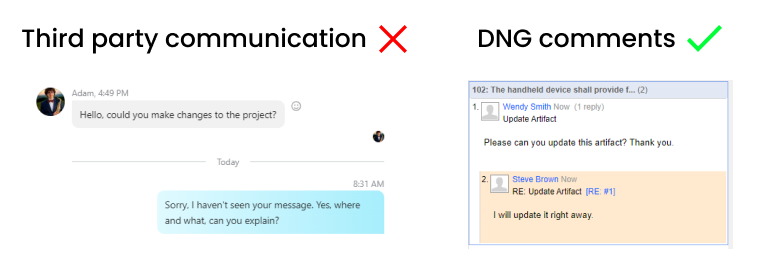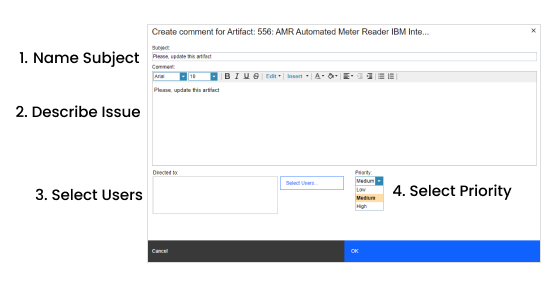Introduction
In this article we will look into one of the lesser known but all the more important features of IBM® Rational® DOORS® Next Generation - comments.
You will learn what they are in context and why you should use them in your projects, how you can interact with them and of course, there will be some useful tips and tricks for the feature.
What are comments?
A comment is a textual item that you can include with an artifact or an aspect within it. When utilizing the feature of commenting, you can give the team suggestions as a product is in the making. New and existing comments appear in the Recent Comments part of the Artifacts page sidebar, the Comments section of an artifact sidebar, and the Recent Comments for Me portion of the individual dashboard in the online client.
Why should you care about them?
Why are they important? Let’s imagine that a group of people is remotely working on a project together. There are many tasks involved in completing any project, some of them are even connected in a way that requires direct cooperation and feedback between two or more of the people working on the project.
Without using the commenting feature, the project can certainly be done but whether it will be done in time for the deadline is questionable.
Contacting and communicating with coworkers while working on the project would be difficult and cumbersome - they would have to use third-party services such as Skype, Gmail, etc. Problems such as technical difficulties on the platform or simply not being able to reach each other could slow down work, not even mentioning the long process of getting across what change needs to be done or where help is needed.
When using the comment feature in IBM® Rational® DOORS® Next Generation however, people working on the project can refer directly to a specific artifact that needs to be changed in some way. They can even direct comments to a specific person so that it is that much clearer what needs to be done and by whom. They will even be notified of this and so will be able to get on the task as quickly as possible.
Using comments will allow the work on the project to proceed smoothly and without any communication bottlenecks between coworkers, since utilizing the comment feature will allow them to pass essential information around quickly and with very little delay between posting the comment and being notified of the change needing to be done. No longer do the coworkers have to get into needless calls about where exactly the change should be made and in what form, comments have got this aspect covered perfectly.

1.) DNG Comments VS Third Party Communication Comparison
Creating comments and interacting with them
Creating a large number of link constraints may be a time-consuming task. If you would like to create link constraints based on the already created and used links and relationships, you can use the “Generate Rules” function. With just only click, relationships between used link types and artifact types are analyzed and link constraint rules are created accordingly.
You can also define a priority, for example high in the case of the implementation of the change being critical for the project. Finally, once you are happy with everything and click Okay, the comment will be sent to the people you have chosen and they can even chose to reply to it (in case of questions or simply letting you know that the change is done)

2.) Interface of Comment Creation WIndow
So you have created a comment. Great! Now what else can be done with comments?
First of all, the basics. A comment can be edited (if a mistake happened) or deleted (if it is no longer needed or it was a mistake). Furthermore, it is possible to reply to a comment or add a new one to an artifact that already has a comment (e.g. a new change has to be made)
The last one that you will most likely need is the option to resolve comments or discussion threads (this is the designated option for when the issue the comment pointed to has been resolved. All of these are the basics needed to be able to work with comments.
Some other useful functions are for example expanding or collapsing comments (this one is useful with long threads dealing with complex issues). You can display recent comments or even specifically the ones meant for you with Recent Comments for Me. Finally, you are able to sort and group comments by their author and date.
Being aware of these possibilities when interacting with comments will allow you to work with them on an advanced level and use them that much more efficiently when it comes to it.

3.) Artifact Comment Window Explanation
Tips and tricks
Finally, we get to the useful additional information that you can use to fully utilize this feature and make the most of it.
You don’t have to comment on an artifact as a whole, you can choose to comment on particular elements of the artifact. When it comes to rich-text artifacts, you have the option to use comments on a document scale and comment on the entire document or a part of it (e.g. paragraph)
If you want to see how many comments there are on an artifact, the number next to their icon will tell you exactly just how many there are.
Finally, one thing that we feel the need to mention is to enhance your experience of using comments through a Softacus created extension. The purpose of this extension is to help you filter comments, which is a feature that you may find very useful on projects with a large volume of posted comments. You can filter them by their Content, Author, Date, State (whether they have been resolved or not) and their Priority. This can help you find the comments that you are looking for faster and more reliably.
The extension is free of charge for customers who purchased the IBM Jazz solution via Softacus.
You can find it HERE:https://softacus.com/extension-articles/doors/filter-comments
Conclusion
The commenting feature in IBM® Rational® DOORS® Next Generation is one that you should not ignore since it can help you increase productivity and decrease work team communication bottlenecks. You should find your projects progressing more smoothly and reliably once you utilize this feature to its full extent.
Softacus Services
We, in Softacus, are experts when it comes to consulting and service delivery of IBM software products and solutions in your business. We help our clients to improve visibility and transparency when licensing and managing commercial software, providing measurable value while increasing efficiency and accountability and we are providing services in different areas (see Softacus Services).
IBM ELM extensions developed by Softacus are free of charge for the customers who ordered IBM ELM licenses via Softacus or for the customers who ordered any of our services. If you are interested in any of our IBM ELM extensions, you found a bug or you have any enhancement request, please let us know at info@softacus.com.
Related and Referenced Topics
Blog Articles:
Basics Of DOORS Next Reviews - learn the basics about the reviews feature in DNG.
Advanced Concepts of DOORS Next Reviews - article explaining advanced concepts of DNG Reviews
Softacus Widgets:
Link Switcher - widget developed by Softacus, that converts the context of artifacts links in a very short time.
Module Link Statistics - extension that provides users with a quick overview of the amount of the links in specific link types in a module.
Link Type Change- extension developed by Softacus designed to enhance the functionality of DOORS Next Generation by allowing users to manipulate the direction of a link or convert it to another type of link.
Links Builder- extension that allows the users to create a link between two artifacts in DOORS Next Generation according to the certain rules.
Link by Foreign Attribute - this extension allows users to create links between artifacts in the selected module(s), based on the attributes values.
Show Attributes of Linked Artifacts - this extension shows the attributes and links of the artifact that is currently selected.




